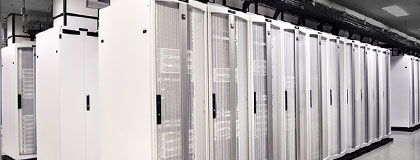 The communications system in most modern sustainable buildings is well beyond a few computer and phone connections. It now includes connections for the security system, audio/video systems, environmental monitoring and intelligent building controls. Additionally, communications technology changes rapidly; so, the initial design needs to anticipate system changes and growth. If your project includes an update, expansion or development of a communications, security or building automation system, here are some resources that will help you deliver the best result.
The communications system in most modern sustainable buildings is well beyond a few computer and phone connections. It now includes connections for the security system, audio/video systems, environmental monitoring and intelligent building controls. Additionally, communications technology changes rapidly; so, the initial design needs to anticipate system changes and growth. If your project includes an update, expansion or development of a communications, security or building automation system, here are some resources that will help you deliver the best result.
Consider a Local Information and Communication Technology (ICT) Designer
Consider adding an ICT design professional to your project team if your electrical engineering consultant does not provide this service. An ICT design professional will select and specify the correct network cabling for the applications and will advise the locations and floor space needed for current and future ICT equipment, including detailed plans for ICT equipment rooms and building cable pathways.
There are several industry certifications for communications design. Some specialize in network design projects, and some specialize in the development of purpose-built computer rooms or data centers. You can contact the certifications providers directly to quickly identify design professionals in California.
ICT cabling system design and planning of ICT equipment rooms and spaces:
Data center and computer room design:
Data center design and certification to meet Uptime Institute® Tier Accreditation for critical facilities:
Data Centers Present Opportunities for Additional Energy Savings
If your project includes a data center or large computer room, there may be opportunities for additional energy savings by implementing proper airflow management practices. Most computer rooms use air to remove heat from equipment. Separating hot and cold air within the room and ducting hot air back to air handlers (heat exchangers) to create a closed return can greatly reduce the volume of air and fan energy required to cool equipment. This practice, called airflow containment, is so effective that it is required in many instances by Title 24, Part 6, of the California Energy Efficiency Standards. However, your client can save more by adjusting operating conditions of their cooling equipment. Your mechanical engineering consultant can learn more about maximizing the economic benefits of containment from the ASHRAE TC9.9 committee, AIA approved training or this white paper. The Department of Energy (DOE), the Environmental Protection Agency (EPA) and the Lawrence Berkeley National Laboratory (LBNL) also publish best practices for thermal management in data centers.
Additionally, new computer equipment operates efficiently in higher temperature air. This may allow some forms of free cooling, economization, the use of return water to cool the computer room and other energy saving methods. Finally, the estimated savings from this design approach may contribute to points for building rating systems like LEED and BREAMM, or provide opportunities to negotiate power savings incentives from the local utility if the reduced power requirement eliminates or reduces the need for the utility to make infrastructure upgrades.
Meeting Seismic Requirements
 As you are well aware, California adopts and updates code regularly to mandate best practices. In the typical communications system design, network cabling distributes throughout a building on overhead pathways and is then consolidated, terminated and managed on vertical equipment racks in a central equipment room. Although these are nonstructural components, they attach to building structure, and therefore must have an anchorage design. Your structural engineering consultant may benefit from the California Office of Statewide Health Planning and Development (OSHPD) Preapproval of Manufacturer’s Certification (OPM) program.
As you are well aware, California adopts and updates code regularly to mandate best practices. In the typical communications system design, network cabling distributes throughout a building on overhead pathways and is then consolidated, terminated and managed on vertical equipment racks in a central equipment room. Although these are nonstructural components, they attach to building structure, and therefore must have an anchorage design. Your structural engineering consultant may benefit from the California Office of Statewide Health Planning and Development (OSHPD) Preapproval of Manufacturer’s Certification (OPM) program.
OSHPD has permitting authority over all health care facilities in California and mandates the most stringent seismic design requirements. The OPM program allows manufacturers to have anchorage designs preapproved for OSHPD permit applications. OPM is a good source for preapproved anchorage designs for the main support components of communications systems: overhead tray and network racks.
Similarly, it is important to recognize that communications infrastructure may need some additional bracing. Network racks let you stack equipment vertically. The ideal solution maximizes the load capacity of the rack to maximize the amount of equipment in the rack. Consequently, a standard rack may need additional overhead bracing, or the equipment load may be derated. Alternately, some manufacturers offer seismic-certified racks that support higher loads in seismic applications. These racks are typically shaker-table tested to confirm stated seismic loads. This type of rack costs more than a standard rack but will give the highest load for the given rack footprint, which means you can fill the rack with equipment, maximizing the floor space.
Planning for Future Growth
As a final note on communications system design, keep in mind that the communications system is probably the building system that will change the most over the life of the building. There are always new technologies and potential upgrades. So, consult an ICT design professional, be flexible in your design and anticipate change.
David Knapp, Product Marketing Manager